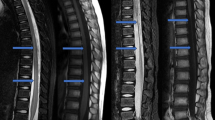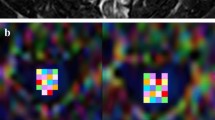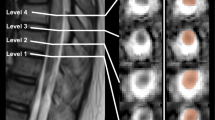Abstract
Study design:
Cross-sectional non-experimental study.
Objectives:
To examine diagnostic accuracy of diffusion tensor imaging (DTI) for pediatric spinal cord injury (SCI).
Setting
Pediatric Orthopedic Hospital.
Methods:
Thirty-five subjects, 10 SCI and 25 controls, mean age 13.38 years underwent two scans with 3.0 T MR scanner. Fractional anisotropy (FA), axial diffusivity (AD) and radial diffusivity (RD) values were calculated. Subjects with SCI underwent examination of muscle strength, sensation and sacral sparing. Mean and s.d. values for FA, AD and RD were compared by group (controls, SCI with sacral sparing, SCI without sacral sparing) using analysis of variance for repeated measures. Comparisons were also made of DTI values at the injury site to values from cervical regions outside of the injury site. Specificity, sensitivity, receiver operating characteristics area under the curve (ROC AUC) and corresponding 95% confidence intervals were calculated. Resampling methods were used to validate the estimates from the final models.
Results:
FA values differed among SCI subjects with intact sacral sparing, absent sacral sparing and controls, P<0.003 (adjusted). DTI values in combination showed the strongest diagnostic accuracy for predicting the presence of anal contraction (AD, RD; ROC AUC=0.90), deep anal pressure (FA; ROC AUC=0.88), S4-5 sensation (FA, RD; ROC AUC=0.93), motor level (FA, AD, RD; ROC AUC=0.92) and MRI level (FA, AD, RD; ROC AUC=0.92). Bootstrap and Jackknife median values indicated consistency of the parameter estimates.
Conclusion:
The predictive accuracy of DTI for sacral sparing end points and motor and MRI level of injury was good to strong.
Similar content being viewed by others
Log in or create a free account to read this content
Gain free access to this article, as well as selected content from this journal and more on nature.com
or
References
Théaudin M, Sailou G, Denier C, Adams D, Ducreux D . A correlation between fractional anisotrophy variations and clinical recovery in spinal cord infarctions. J Neuroimaging 2013; 23: 256–258.
Kamble RB, Venkataramana NK, Naik AL, Rao SV . Diffusion tensor imaging in spinal cord injury. Indian J Radiol Imaging 2011; 21: 221–224.
Lindberg PG, Feydy A, Sanchez K, Rannou F, Maier MA . Measures of spinal canal steneosis and relationship to spinal cord structure in patients with cervical spondylosis. J Neuroradiol 2011; 39: 236–242.
Petersen JA, Wilm BJ, vonMeyenburg J, Schubert M, Seifert B, Najafi Y et al. Chronic cervical spinal cord injury: DTMRI correlates with clinical and electrophysiological measures. J Neurotrauma 2011; 29: 1556–1566.
Cheran S, Shanmuganathan K, Zhuo J, Mirvis SE, Aarabi B, Alexander MT et al. Correlation of MR diffusion tensor imaging parameters with ASIA motor scores in hemorrhagic and nonhemorrhagic acute spinal cord injury. J Neurotrauma 2011; 28: 1881–1892.
Cohen-Adad J, El Mendili M-M, Lehericy S, Pradat P-F, Blancho S, Rossignol S et al. Demyelination and degeneration in the injured human spinal cord detected with diffusion and magnetization transfer MRI. NeuroImage 2011; 55: 1024–1033.
Mulcahey MJ, Vogel L, Betz R, Samdani A, Chafetz R, Gaughan J . The international standards for neurological classification of spinal cord injury: psychometric evaluation and guidelines for use with children and youth. Phys Med Rehabil 2011; 92: 1264–1269.
Calhoun C, Chafetz R, Mulcahey MJ . Discrepancy between severity obtained from examinations and classification conducted by experienced examiners and classifiers and documented severity in paediatric spinal cord injury. Dev Neurorehabil 2009; 12: 406–410.
Mulcahey MJ, Gaughan J, Betz RR . Agreement of ISCSCI scores at individual myotomes and dermatomes in youth with complete injuries. Spinal Cord 2009; 47: 56–61.
Krisa L, Gaughan J, Vogel L, Betz RR, Mulcahey MJ . Agreement of repeated motor and sensory scres at individual myotomes and dermatomes in young persons with spinal cord injury. Spinal Cord 2012; 51: 75–81.
Mulcahey MJ, Samdani AF, Gaughan JP, Barakat N, Faro S, Betz RR et al. Diffusion tensor imaging in pediatric spinal cord injury: preliminary examination of reliability and clinical correlation. Spine 2011; 37: E797–E803.
Mohamed F, Hunter L, Barakat N, Chia-Shang J, Sair H, Samdani A et al. Diffusion tensor imaging of the pediatric spinal cord at 1.5 T: preliminary results. Am J Neuroradiol 2011; 32: 339–345.
Barakat N, Mohamed F, Hunter L, Shah L, Faro S, Samdani A et al. Diffusion tensor imaging of the normal pediatric spinal cord using an inner-FoV EPI sequence. Am J Neuroradiol 2012; 33: 1127–1133.
Kirshblum SC, Waring W, Biering-Sorensen F, Burns SP, Johansen M, Schmidt-Read M et al. Reference for the 2011 revision of the International Standards for Neurological Classification of Spinal Cord Injury. J Spinal Cord Med 2011; 34: 547–554.
Finsterbusch J . Eddy-current compensated diffusion weighting with a single refocusing RF pulse. Magn Reson Med 2009; 61: 748–754.
Van Middendorp JJ, Horman AJ, Pouw MH, van de Meent H . Is determination between complete and incomplete traumatic spinal cord injury clinically relevant? Validation of the ASIA sacral sparing criteria in a prospective cohort of 432 patients. Spinal Cord 2009; 47: 809–816.
Vogel L, Samdani A, Chafetz R, Gaughan J, Mulcahey MJ . Intra-rater reliability of the anorectal exam and classification of injury in children with spinal cord injury. Spinal Cord 2009; 47: 687–691.
Facon D, Ozanne A, Fillard P, Lepeintre JF, Tournoux-Facon C, Ducreux D . MR diffusion tensor imaging and fiber tracking in spinal cord compression. Am J Neuroradiol 2005; 26: 1587–1594.
Huisman TA, Loenneker T, Barta G, Bellemann ME, Hennig J, Fischer JE et al. Quantitative diffusion tensor MR imaging of the brain: field strength related variance of apparent diffusion coefficient (ADC) and fractional anisotropy (FA) scalars. Eur Radiol 2006; 16: 1651–1658.
Mortazavi MM, Mariwalla NR, Horn EM, Tubbs RS, Theodore N . Absence of MRI soft tissue abnormalities in severe spinal cord injury in children: case-based update. Childs Nerv Syst 2011; 27: 1369–1373.
Acknowledgements
Christina Calhoun, MSPT and Laure Rutter, BSN assisted with recruitment and data collection. The study was funded by the Shriners Hospitals for Children Research Grant 8956 (Mulcahey, PI, USA).
Author information
Authors and Affiliations
Corresponding author
Ethics declarations
Competing interests
The authors declare no conflict of interest.
Rights and permissions
About this article
Cite this article
Mulcahey, M., Samdani, A., Gaughan, J. et al. Diagnostic accuracy of diffusion tensor imaging for pediatric cervical spinal cord injury. Spinal Cord 51, 532–537 (2013). https://doi.org/10.1038/sc.2013.36
Received:
Revised:
Accepted:
Published:
Issue date:
DOI: https://doi.org/10.1038/sc.2013.36
Keywords
This article is cited by
-
Clinical characteristics analysis of pediatric spinal cord injury without radiological abnormality in China: a retrospective study
BMC Pediatrics (2024)
-
Diagnostic efficacy of tract-specific diffusion tensor imaging in cervical spondylotic myelopathy with electrophysiological examination validation
European Spine Journal (2024)
-
The correlation between diffusion tensor imaging of the sacral cord and bladder contractility in people with tetraplegia
Spinal Cord (2020)
-
Reduced FOV diffusion tensor MR imaging and fiber tractography of pediatric cervical spinal cord injury
Spinal Cord (2017)
-
Measures and Outcome Instruments for Pediatric Spinal Cord Injury
Current Physical Medicine and Rehabilitation Reports (2016)



